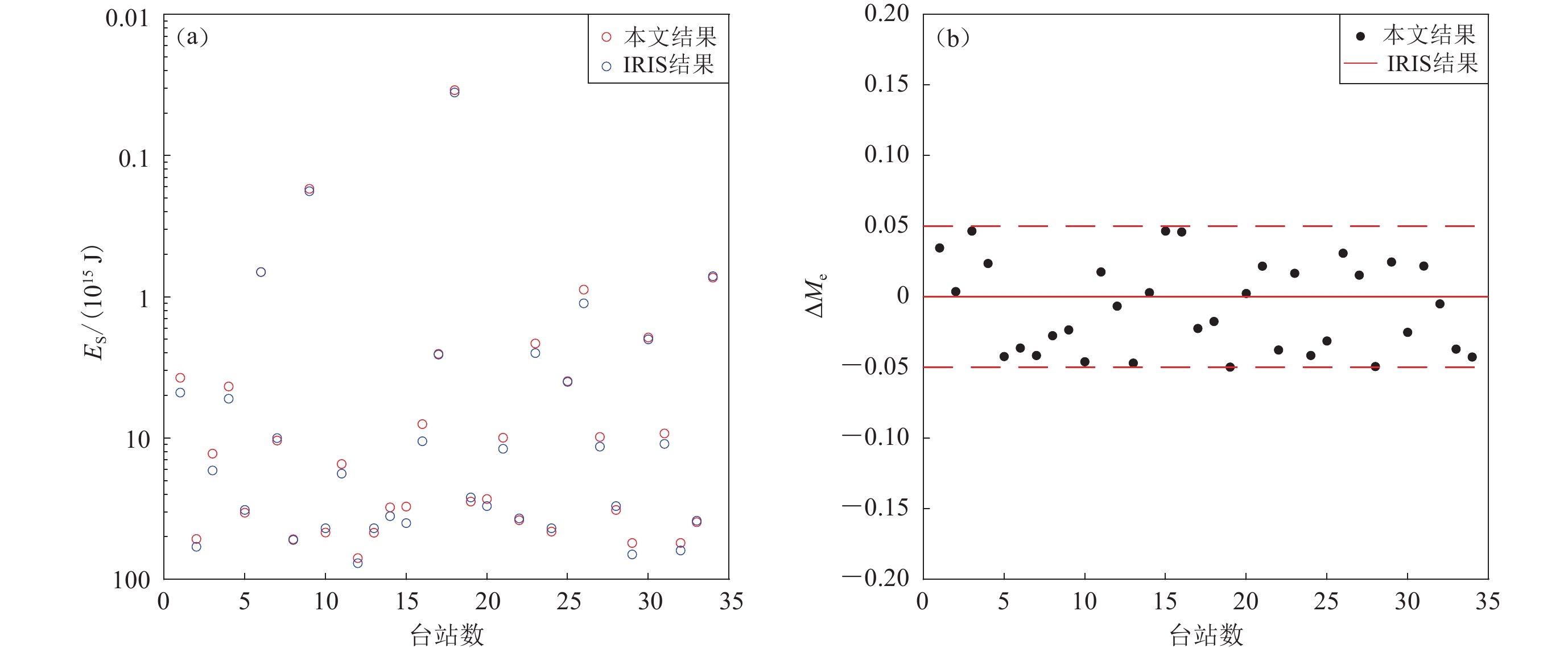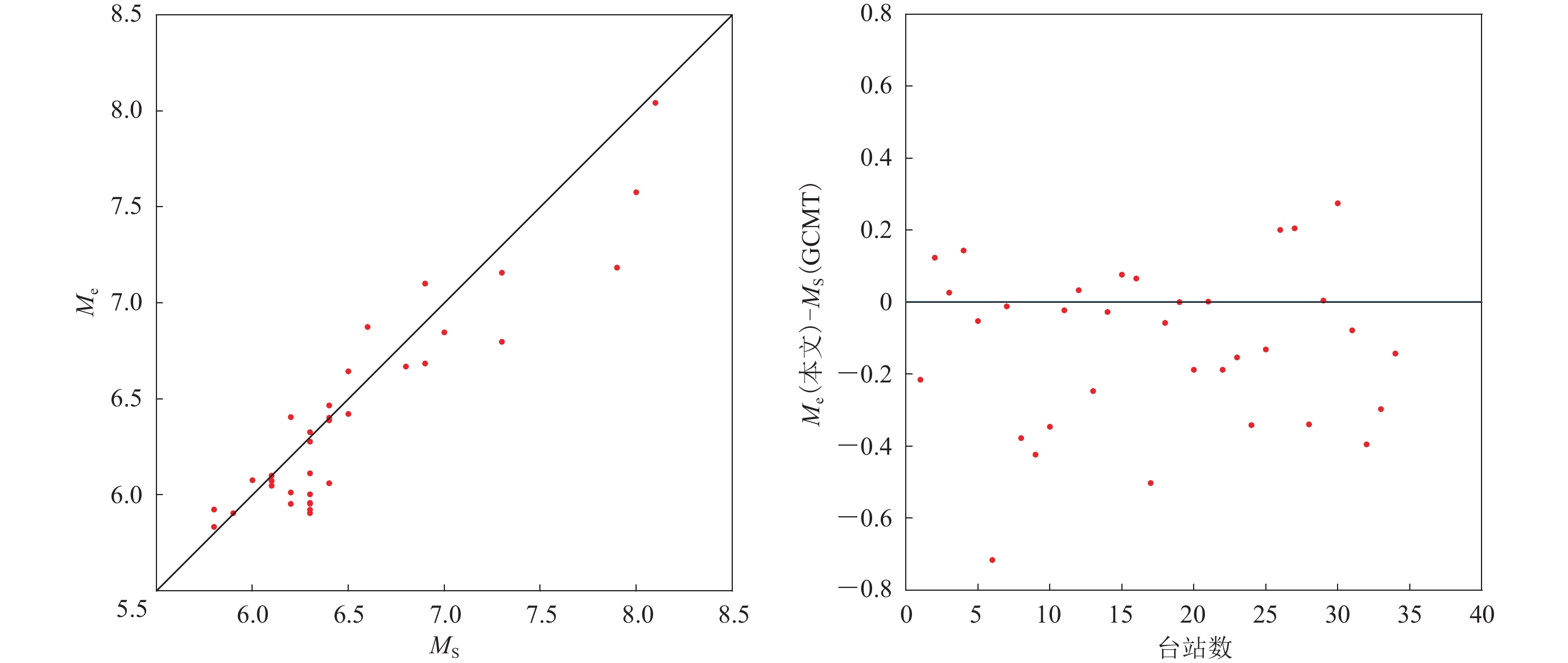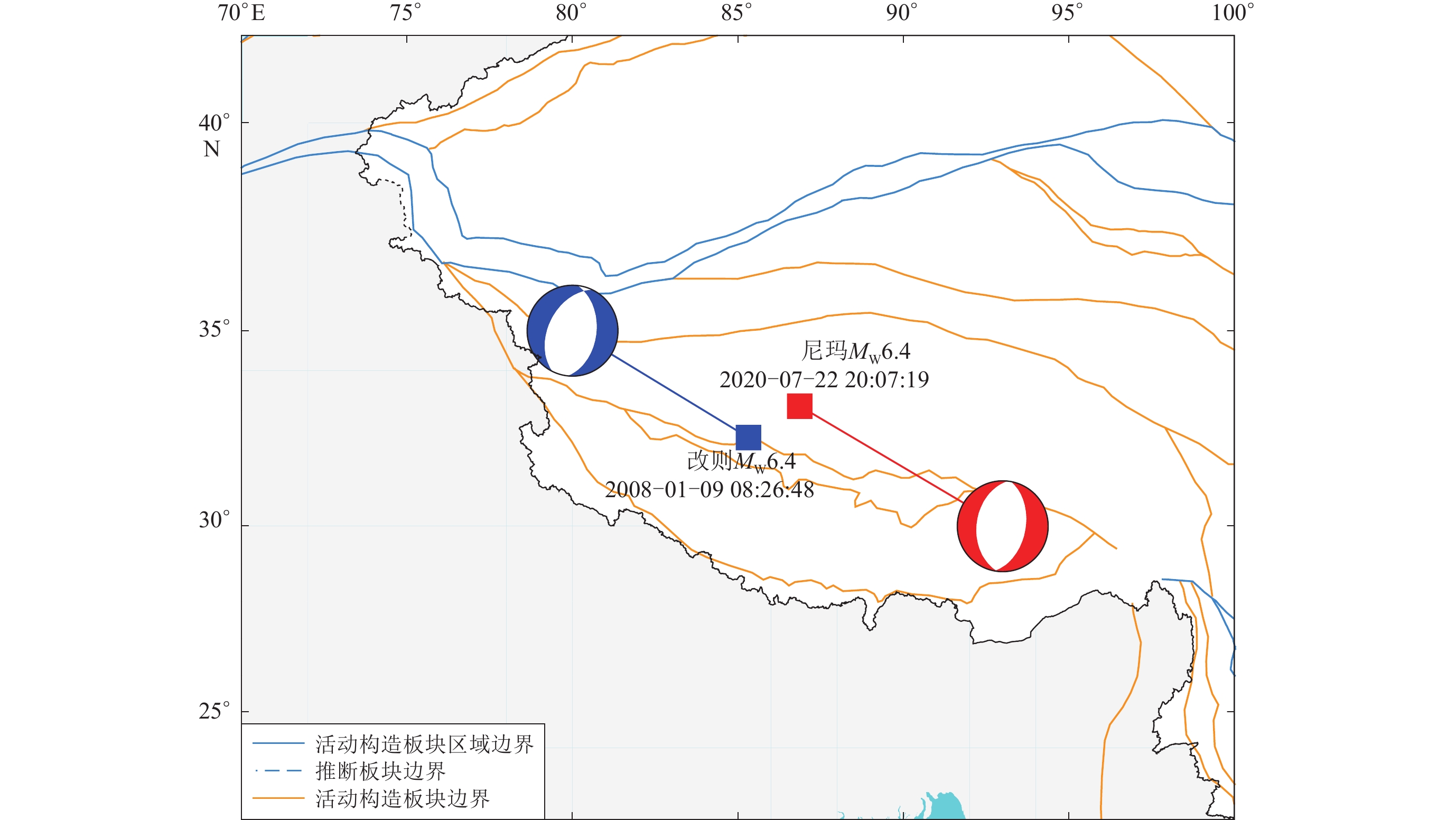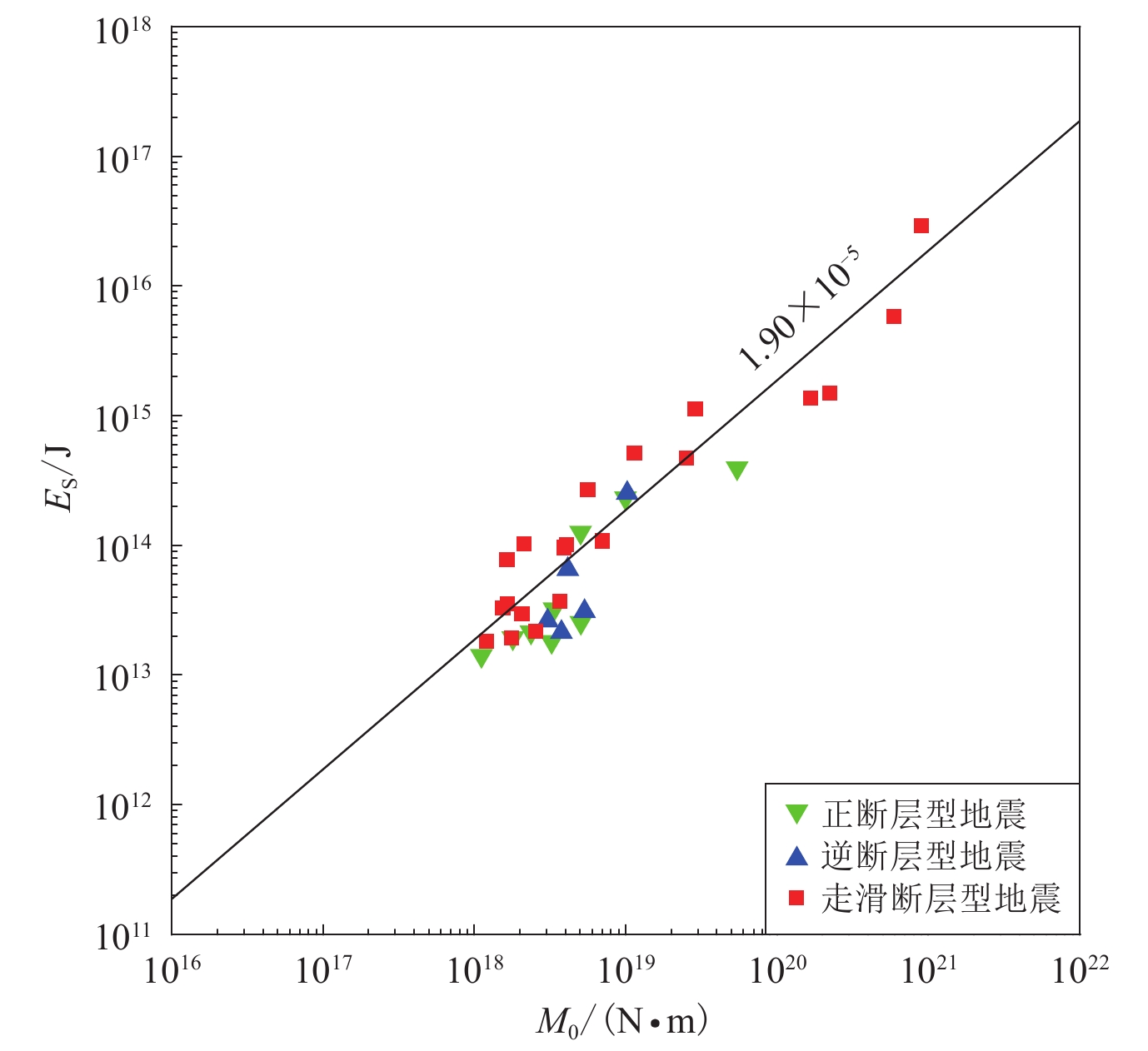Determination of the radiated seismic energy for M≥6.0 earthquakes in the Qinghai-Xizang Plateau
-
摘要:
地震辐射能量主要由高频体波携带,与震源动态特征直接相关,能够有效地弥补地震矩和矩震级对震源动态过程和高频成分描述的不足,为地震应急和灾害评估提供更为全面的参考。本文使用自主研发的地震辐射能量测定软件测定了中国青藏高原自1990年以来M≥6.0浅源地震的地震辐射能量,并初步分析了中国青藏高原地区浅源地震的能量释放规律。研究结果表明:① 利用该软件测定的中国青藏高原地区的34例浅源地震所得的测定结果稳定可靠。在一般情况下,地震的矩震级MW 与能量震级Me并不相等,为了更全面地评估地震动效应,不仅需要考虑地震断层错动的静态特征,还需要考虑震源的动态特性。因此,在表示震源特性时,矩震级MW 和能量震级Me 各有特点,优势互补。② 改则地震和尼玛地震的能量震级分别为6.47和6.00,地震辐射能量分别为1.26×1014 J和0.25×1014 J。两次震源位置相近、矩震级相同的地震,所释放的能量相差5倍之多。为了探究改则地震与尼玛地震能量释放差异的原因,我们通过S变换对两次地震的波形进行了时频分析。结果表明,震源动态过程的不同导致了地震辐射能量释放过程的差异。因此能量震级和地震辐射能量等动态震源参数比矩震级更适合描述震源的动态过程和地震的潜在破坏性。③ 结合地震矩资料得到中国青藏高原地区浅源地震的平均能矩比为1.9×10−5,是全球浅源地震平均能矩比的1.6倍。能矩比的大小与震源机制有关,走滑型地震的平均能矩比高于倾滑型地震。④ 中国青藏高原浅源地震的能矩比分布存在区域特征,东部和西部平均能矩比分别为2.25×10−5和1.62×10−5,东部明显高于西部。能矩比的区域性差异与地质构造背景有关,地震辐射能量能够反映该地区的地质构造状态。同一区域内地震的能矩比也存在差别,中国青藏高原地区浅源地震的能矩比范围为5.03×10−6—4.80×10−5,反映了不同断层上发生的地震能量释放过程存在差异。因此,为全面反映地震的震源特性有必要进行能量震级和矩震级的联合测定。
Abstract:This study focuses on the radiated seismic energy of earthquakes with a magnitude of 6.0 or greater in Qinghai-Xizang Plateau of China, a region known for its seismic activity due to its unique tectonic setting. Radiated seismic energy, predominantly carried by highfrequency body waves, is a critical parameter that reflects the dynamic rupture process of an earthquake and complements the static characteristics described by seismic moment and moment magnitude. The accurate measurement of the radiated seismic energy is essential for a comprehensive understanding of earthquake dynamics, emergency response, and disaster assessment. The research utilized self-developed software to measure the radiated seismic energy of shallow earthquakes with a moment magnitude (MW) above 6.0 that occurred in QinghaiXizang Plateau since 1990. The study involved 34 earthquakes and aimed to analyze the energy release patterns in the region. It will help us to enhance our understanding of energy release patterns and their implications for seismic hazard assessment.
Introduction
The Qinghai-Xizang Plateau, often referred to as the “Roof of the World”, is not only a significant geographical feature but also a critical area for the study of seismic activity due to its location at the convergence of multiple tectonic plates. The region’s seismicity is influenced by the ongoing collision and compression of the Indian Plate with the Eurasian Plate, leading to a high potentiality for earthquake occurrences. The accurate measurement and analysis of radiated seismic energy are crucial for the potential hazards assessment posed by earthquakes, emergency response strategies forewarning, and guidance on the development of resilient infrastructure.
Methodology
The study employed a self-developed software to measure the radiated seismic energy of shallow earthquakes with a moment magnitude (MW) above 6.0. The software operates on the principles of point-source modeling and integrates the seismic moment rate spectrum over a specific frequency range to calculate the radiated energy. The methodology incorporates corrections for geometric spreading and frequency-dependent attenuation, ensuring the reliability and accuracy of the measurements. Data from the Incorporated Research Institutions for Seismology (IRIS) and the Global Seismic Network (GSN) were utilized to provide a robust dataset for the analysis.
Results
The research findings reveal several key insights into the radiated seismic energy and energy release patterns in the Qinghai-Xizang Plateau:
1) Stability and reliability of measurements: The radiated energy measurements for the 34 selected earthquakes were found to be stable and reliable, showing a high degree of consistency with that of the IRIS database. This validation confirms the effectiveness of the self-developed software in accurately determining radiated seismic energy.
2) Diversity in energy release: A significant variation in the energy release was observed between earthquakes, even those with similar MW and epicentral locations. For instance, the Garze and Nyima earthquakes, both with a moment magnitude of 6.4, exhibited substantial differences in their radiated energy and energy magnitude (Me), underscoring the importance of considering both static and dynamic characteristics of seismic sources.
3) Regional characteristics of energy-to-moment ratio: The study identified distinct regional characteristics in the energy-to-moment ratio, with an average ratio (1.90×10−5) for Qinghai-Xizang Plateau which is 1.6 times higher than the global average. This suggests that earthquakes in this region are more energetically efficient, potentially leading to greater seismic hazards. A regional characteristic in the distribution of the energy-to-moment ratio was identified, with the eastern part of Qinghai-Xizang Plateau exhibiting a higher average ratio (2.25×10−5) than the western part (1.62×10−5). This regional variation is believed to be linked to the geological structure background, indicating that radiated seismic energy can reflect the regioral geological state.
4) Mechanism-dependent energy release: The energy-to-moment ratio was found to be dependent on the focal mechanism of the earthquake, with strike-slip earthquakes exhibiting higher ratios compared to dip-slip earthquakes. This relationship provides valuable insights into the tectonic processes underlying seismic activity in the region. The study also found that within the same region, there is a significant range in the energy-to-moment ratio (from 5.03×10−6 to 4.80×10−5), reflecting differences in energy release processes on various faults. The research concludes that the measurement of both energy magnitude and moment magnitude is necessary for fully understanding the source characteristics of an earthquake. The findings contribute to a better understanding of the potential destructiveness of earthquakes in Qinghai-Xizang Plateau and provide valuable insights for earthquake emergency response and disaster mitigation efforts in the region.
5) Geological significance: The regional variation in the energy-to-moment ratio appears to correlate with the underlying geological structure, indicating that the radiated seismic energy can serve as an indicator of the geological state and stress accumulation levels in the region.
Discussion
The research findings underscore the complexity of seismic energy release in Qinghai-Xizang Plateau and the need for a comprehensive assessment of earthquake hazards. The identification of regional characteristics in the energy-to-moment ratio provides valuable insights into the potentiality for seismic risk and the underlying tectonic processes. The research also highlights the importance of considering both the static (seismic moment and moment magnitude) and dynamic (radiated energy and energy magnitude) aspects of earthquakes for a more thorough understanding of their hazards.
The energy release patterns observed in this study have significant implications for the development of seismic hazard maps and the implementation of risk mitigation strategies. The higher energy release efficiency observed in Qinghai-Xizang Plateau suggests that earthquakes in this region may pose a greater threat to human settlements and infrastructure, necessitating enhanced preparedness and response capabilities.
Conclusion
The comprehensive analysis of radiated seismic energy in Qinghai-Xizang Plateau presented in this study contributes to a more nuanced understanding of earthquake dynamics in this seismically active region. The findings have significant implications for seismic hazard assessment and disaster mitigation strategies. By revealing the regional variations in energy release and their relationship with geological structures, this research aids in the development of targeted approaches to earthquake risk management in Qinghai-Xizang Plateau.
-
-
表 1 中国青藏高原浅源地震的震源参数
Table 1 Source parameters of shallow earthquakes in Qinghai-Xizang Plateau in China
发震日期
a-mo-d震中位置 震源
深度
/kmM0
/(1018 N·m)MW MS ES
/(1013J)Me I Me 震源机制
类型参考位置 东经/° 北纬/° 1 990-04-26 100.28 36.02 10.0 5.61 6.4 6.9 26.7 6.65 6.68 走滑型 青海共和 1 992-07-30 90.18 29.57 31.4 1.79 6.1 5.8 1.93 5.92 5.92 正断型 西藏尼木 1 993-10-02 88.66 38.17 14.1 1.64 6.1 6.3 7.76 6.28 6.33 走滑型 新疆若羌 1 996-02-03 100.29 27.29 10.0 9.94 6.6 6.5 23.2 6.62 6.64 正断型 云南丽江 1 997-04-11 96.95 39.56 20.0 2.06 6.1 6.1 2.96 6.09 6.05 走滑型 新疆伽师 1 997-11-08 87.37 35.12 38.1 223 7.5 7.9 150 7.22 7.18 走滑型 西藏尼玛 1 998-08-27 77.34 39.58 33.0 3.89 6.3 6.4 9.61 6.43 6.39 走滑型 新疆伽师 2 000-09-12 99.37 35.37 12.0 1.76 6.1 6.3 1.92 5.95 5.92 走滑型 青海兴海 2 001-11-14 90.59 35.93 11.0 590 7.8 8.0 582 7.60 7.58 走滑型 昆仑山口 2 003-02-24 77.21 39.52 26.2 3.74 6.3 6.3 2.14 6.00 5.95 逆断型 巴楚—伽师 2 003-04-17 96.51 37.52 15.0 4.12 6.3 6.3 6.55 6.26 6.28 逆断型 青海德令哈 2 004-03-27 89.18 33.99 9.0 1.11 6.0 5.8 1.41 5.84 5.83 正断型 西藏班戈 2 004-07-11 83.67 30.72 8.1 2.36 6.2 6.2 2.14 6.00 5.95 正断型 西藏仲巴 2 005-04-07 83.66 30.52 14.7 3.35 6.3 6.1 3.23 6.07 6.07 正断型 西藏仲巴 2 007-05-05 82.03 34.27 14.2 1.54 6.1 6.0 3.27 6.03 6.08 走滑型 日土—改则 2 008-01-09 85.26 32.4 27.7 5.02 6.4 6.4 12.6 6.42 6.47 正断型 西藏改则 2 008-03-20 81.51 35.55 10.0 54.3 7.1 7.3 39.5 6.82 6.80 正断型 新疆于田 2 008-05-12 103.37 31.06 7.6 897 7.9 8.1 2910 8.06 8.04 逆冲型 四川汶川 2 008-05-12 103.63 31.24 11.5 1.65 6.1 6.1 3.55 6.15 6.10 走滑型 四川汶川 2 008-10-06 90.38 29.84 6.4 3.65 6.3 6.3 3.70 6.11 6.11 走滑型 西藏当雄 2 008-11-10 95.89 37.62 0.1 4.06 6.3 6.4 10.1 6.38 6.40 走滑型 青海海西 2 009-08-28 95.76 37.67 12.1 3.04 6.3 6.2 2.62 6.05 6.01 逆断型 青海海西 2 010-04-13 96.75 33.19 13.8 25.3 6.9 7.0 46.8 6.83 6.85 走滑型 青海玉树 2 012-08-12 82.54 35.65 14.0 2.55 6.2 6.3 2.18 6.00 5.96 走滑型 新疆于田 2 013-04-20 103.02 30.27 18.0 10.2 6.6 6.8 25.3 6.70 6.67 逆断型 四川雅安 2 014-02-12 82.58 35.88 4.1 28.7 6.9 6.9 113 7.07 7.10 走滑型 新疆于田 2 014-08-03 103.43 27.25 10.0 2.12 6.2 6.2 10.2 6.39 6.41 走滑型 云南鲁甸 2 015-07-03 78.12 37.47 19.0 5.33 6.4 6.4 3.10 6.11 6.06 逆断型 新疆皮山 2 016-10-17 94.87 32.91 32.1 1.20 6.0 5.9 1.81 5.88 5.90 走滑型 青海杂多 2 016-11-25 74.02 39.23 17.0 11.3 6.6 6.6 51.6 6.90 6.87 走滑型 新疆阿克陶 2 017-08-08 103.86 33.19 9.0 6.98 6.5 6.5 10.8 6.40 6.42 走滑型 四川九寨沟 2 020-06-25 82.42 35.59 10.0 3.23 6.3 6.3 1.81 5.91 5.91 正断型 新疆于田 2 020-07-22 86.87 33.15 10.0 5.04 6.4 6.3 2.54 6.04 6.00 正断型 西藏尼玛 2 021-05-21 98.24 34.59 10.0 166 7.4 7.3 137 7.20 7.16 走滑型 青海玛多 注:经纬度信息及MeI来自IRIS;M0,MW和MS来自GCMT;ES和Me为本文测定的地震辐射能量和能量震级。 表 2 西藏改则地震和尼玛地震的地震参数
Table 2 Earthquake parameters of the Gerze MW6.4 earthquake and Niyma MW6.4 earthquake
发震地点 发震日期 震源深度/km MW Me 辐射能量/(1014J) 能矩比/10−5 震源机制类型 改则 2 008-01-09 13.3 6.4 6.47 1.26 2.5 正断型 尼玛 2 020-07-22 16.8 6.4 6.00 0.25 0.5 正断型 -
陈运泰,顾浩鼎. 1990. 震源理论基础(上册)[M]. 北京:中国地震局地球物理研究所:1−190. Chen Y T,Gu H D. 1990. The Theoretical Basis of Earthquake Source (Volume I)[M]. Beijing:Institute of Geophysics,China Earthquake Administration:1−190 (in Chinese).
孔韩东,刘瑞丰,边银菊,李赞,王子博,胡岩松. 2022. 地震辐射能量测定方法研究及其在汶川8.0级地震中的应用[J]. 地球物理学报,65(12):4775–4788. doi: 10.6038/cjg2022Q0169 Kong H D,Liu R F,Bian Y J,Li Z,Wang Z B,Hu Y S. 2022. Research on the method to determine the seismic radiated energy and its application in Wenchuan M8.0 earthquake[J]. Chinese Journal of Geophysics,65(12):4775–4788 (in Chinese).
王子博,刘瑞丰,孙丽,李赞,孔韩东. 2021. 2021年云南漾濞MS6.4地震辐射能量的快速测定[J]. 地震地质,43(4):908–919. doi: 10.3969/j.issn.0253-4967.2021.04.011 Wang Z B,Liu R F,Sun L,Li Z,Kong H D. 2021. The rapid determination of radiated seismic energy of MS6.4 Yangbi earthquake[J]. Seismology and Geology,43(4):908–919 (in Chinese).
肖龙,王春增,Pirajno F. 2005. 青藏高原东西向地质构造差异及其成因探讨[C]//青藏高原地质过程与环境灾害效应学术讨论会. 北京:中国地质学会:221−227. Xiao L,Wang C Z,Pirajno F. 2005. Geological tectonic differences and their causes in the east-west direction of the Qinghai-Xizang Plateau[C]//In Proceedings of the Academic Symposium on Geological Processes and Environmental Disaster Effects in the Qinghai-Xizang Plateau. Beijing:Geological Society of China:221−227 (in Chinese).
张培震. 1999. 中国大陆岩石圈最新构造变动与地震灾害[J]. 第四纪研究,(5):404–413. doi: 10.3321/j.issn:1001-7410.1999.05.003 Zhang P Z. 1999. Late Quaternary tectonic deformation and earthquake hazard in continental China[J]. Quaternary Sciences,(5):404–413 (in Chinese).
Allmann B P,Shearer P M. 2009. Global variations of stress drop for moderate to large earthquakes[J]. J Geophys Res:Solid Earth,114(B1):B01310.
Baltay A S,Beroza G C,Ide S. 2014. Radiated energy of great earthquakes from teleseismic empirical Green’s function deconvolution[J]. Pure Appl Geophys,171(10):2841–2862. doi: 10.1007/s00024-014-0804-0
Ben-Menahem A,Singh S J. 1981. Seismic Waves and Sources[M]. New York:Springer:622−767.
Boatwright J,Choy G L. 1986. Teleseismic estimates of the energy radiated by shallow earthquakes[J]. J Geophys Res:Solid Earth,91(B2):2095–2112. doi: 10.1029/JB091iB02p02095
Boatwright J,Choy G L,Seekins L C. 2002. Regional estimates of radiated seismic energy[J]. Bull Seismol Soc Am,92(4):1241–1255. doi: 10.1785/0120000932
Boatwright J,Seekins L. 2011. Regional spectral analysis of three moderate earthquakes in northeastern North America[J]. Bull Seismol Soc Am,101(4):1769–1782. doi: 10.1785/0120100225
Bormann P,Baumbach M,Bock G,Grosser H,Choy G L,Boatwright J. 2002. Seismic sources and source parameters[M]//New Manual of Seismological Observatory Practice. Potsdam:Deutsches GeoForschungsZentrum:1−94.
Brune J N. 1996. Particle motions in a physical model of shallow angle thrust faulting[J]. Proc Indian Acad Sci:Earth Planet Sci,105(2):197–206. doi: 10.1007/BF02876014
Choy G L,Boatwright J L. 1995. Global patterns of radiated seismic energy and apparent stress[J]. J Geophys Res:Solid Earth,100(B9):18205–18228. doi: 10.1029/95JB01969
Choy G L,Kirby S H. 2004. Apparent stress,fault maturity and seismic hazard for normal-fault earthquakes at subduction zones[J]. Geophys J Int,159(3):991–1012. doi: 10.1111/j.1365-246X.2004.02449.x
Choy G L,McGarr A,Kirby S H,Boatwright J. 2006. An overview of the global variability in radiated energy and apparent stress[M]//Earthquakes:Radiated Energy and the Physics of Faulting. Washington,DC:American Geophysical Union:43−57.
Choy G L,Boatwright J. 2009. Differential energy radiation from two earthquakes in Japan with identical MW:The Kyushu 1996 and Tottori 2000 earthquakes[J]. Bull Seismol Soc Am,99(3):1815–1826. doi: 10.1785/0120080078
Choy G L. 2012. Stress conditions inferable from modern magnitudes:Development of a model of fault maturity[M]//New Manual of Seismological Observatory Practice 2 (NMSOP-2). Potsdam:Deutsches GeoForschungsZentrum:1−10.
Convers J A,Newman A V. 2011. Global evaluation of large earthquake energy from 1997 through mid-2010[J]. J Geophys Res:Solid Earth,116(B8):B08304.
Di Giacomo D,Grosser H,Parolai S,Bormann P,Wang R J. 2008. Rapid determination of Me for strong to great shallow earthquakes[J]. Geophys Res Lett,35(10):L10308.
Di Giacomo D. 2010. Determination of the Energy Magnitude Me:Application to Rapid Response Purposes and Insights to Regional/Local Variabilities[D]. Potsdam:Universität Potsdam:1−132.
Di Giacomo D,Parolai S,Bormann P,Grosser H,Saul J,Wang R J,Zschau J. 2010. Suitability of rapid energy magnitude determinations for emergency response purposes[J]. Geophys J Int,180(1):361–374. doi: 10.1111/j.1365-246X.2009.04416.x
Gutenberg B,Richter C F. 1956. Earthquake magnitude,intensity,energy,and acceleration[J]. Bull Seismol Soc Am,46(2):105–145. doi: 10.1785/BSSA0460020105
Hanks T C,Kanamori H. 1979. A moment magnitude scale[J]. J Geophys Res:Solid Earth,84(B5):2348–2350. doi: 10.1029/JB084iB05p02348
Haskell N A. 1964. Total energy and energy spectral density of elastic wave radiation from propagating faults[J]. Bull Seismol Soc Am,54(6A):1811–1841. doi: 10.1785/BSSA05406A1811
Hauksson E. 1990. Earthquakes,faulting,and stress in the Los Angeles Basin[J]. J Geophys Res:Solid Earth,95(B10):15365–15394. doi: 10.1029/JB095iB10p15365
Husseini M I. 1977. Energy balance for motion along a fault[J]. Geophys J Int,49(3):699–714. doi: 10.1111/j.1365-246X.1977.tb01313.x
Ide S,Beroza G C. 2001. Does apparent stress vary with earthquake size?[J]. Geophys Res Lett,28(17):3349–3352. doi: 10.1029/2001GL013106
Kanamori H,Mori J,Hauksson E,Heaton T H,Hutton L K,Jones L M. 1993. Determination of earthquake energy release and ML using Terrascope[J]. Bull Seismol Soc Am,83(2):330–346.
Kanamori H,Heaton T H. 2000. Microscopic and macroscopic physics of earthquakes[M]//Geocomplexity and the Physics of Earthquakes. Washington,DC:American Geophysical Union:147−163.
Kanamori H,Rivera L. 2006. Energy partitioning during an earthquake[M]//Earthquakes:Radiated Energy and the Physics of Faulting. Washington,DC:American Geophysical Union:3−13.
Kanamori H,Ross Z E,Rivera L. 2020. Estimation of radiated energy using the KiK-net downhole records-old method for modern data[J]. Geophys J Int,221(2):1029–1042. doi: 10.1093/gji/ggaa040
Lay T,Wallace T C. 1995. Modern Global Seismology[M]. San Diego:Academic Press:1−521.
Mayeda K,Walter W R. 1996. Moment,energy,stress drop,and source spectra of western United States earthquakes from regional coda envelopes[J]. J Geophys Res:Solid Earth,101(B5):11195–11208. doi: 10.1029/96JB00112
Mayeda K,Hofstetter A,O’Boyle J L,Walter W R. 2003. Stable and transportable regional magnitudes based on coda-derived moment-rate spectra[J]. Bull Seismol Soc Am,93(1):224–239. doi: 10.1785/0120020020
Montagner J P,Kennett B L N. 1996. How to reconcile body-wave and normal-mode reference Earth models[J]. Geophys J Int,125(1):229–248. doi: 10.1111/j.1365-246X.1996.tb06548.x
Morasca P,Mayeda K,Malagnini L,Walter W R. 2005. Coda-derived source spectra,moment magnitudes and energy-moment scaling in the western Alps[J]. Geophys J Int,160(1):263–275.
Newman A V,Okal E A. 1998. Teleseismic estimates of radiated seismic energy:The E/M0 discriminant for tsunami earthquakes[J]. J Geophys Res:Solid Earth,103(B11):26885–26898. doi: 10.1029/98JB02236
Okal E A. 2019. Energy and magnitude:A historical perspective[J]. Pure Appl Geophys,176(9):3815–3849. doi: 10.1007/s00024-018-1994-7
Parolai S. 2009. Denoising of seismograms using the S transform[J]. Bull Seismol Soc Am,99(1):226–234. doi: 10.1785/0120080001
Pérez-Campos X,Beroza G C. 2001. An apparent mechanism dependence of radiated seismic energy[J]. J Geophys Res:Solid Earth,106(B6):11127–11136. doi: 10.1029/2000JB900455
Rudnicki J W,Freund L B. 1981. On energy radiation from seismic sources[J]. Bull Seismol Soc Am,71(3):583–595.
Singh S K,Ordaz M. 1994. Seismic energy release in Mexican subduction zone earthquake[J]. Bull Seismol Soc Am,84(5):1533–1550.
Stockwell R G,Mansinha L,Lowe R P. 1996. Localization of the complex spectrum:The S transform[J]. IEEE Trans Signal Process,44(4):998–1001. doi: 10.1109/78.492555
Tajima R,Tajima F. 2007. Seismic scaling relations and aftershock activity from the sequences of the 2004 mid Niigata and the 2005 west off Fukuoka earthquakes (MW6.6) in Japan[J]. J Geophys Res:Solid Earth,112(B10):B10302.
Vassiliou M S,Kanamori H. 1982. The energy release in earthquakes[J]. Bull Seismol Soc Am,72(2):371–381.
Venkataraman A,Kanamori H. 2004a. Effect of directivity on estimates of radiated seismic energy[J]. J Geophys Res:Solid Earth,109(B4):B04301.
Venkataraman A,Kanamori H. 2004b. Observational constraints on the fracture energy of subduction zone earthquakes[J]. J Geophys Res:Solid Earth,109(B5):B05302.
Wessel P,Smith W. 1991. Free software helps map and display data[J]. Eos Trans AGU,72:441 doi: 10.1002/2015JB012426





 下载:
下载:







